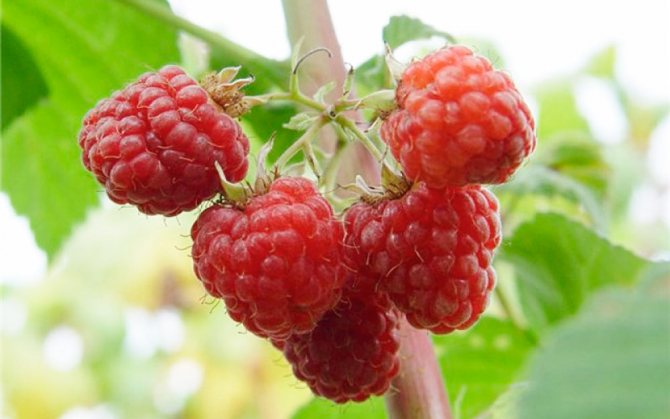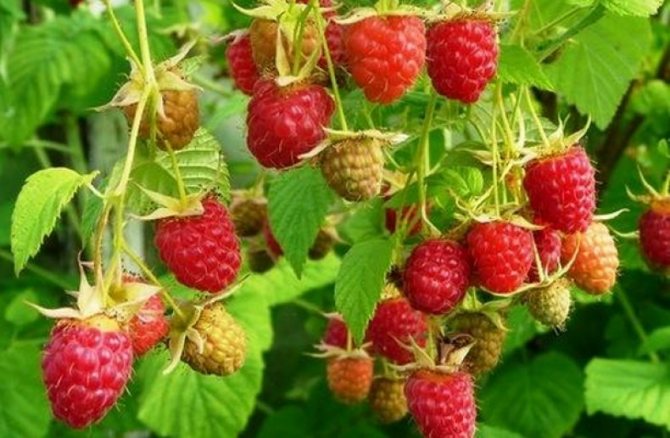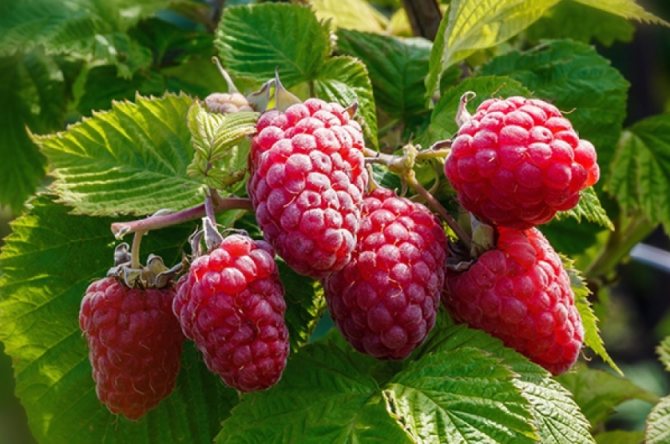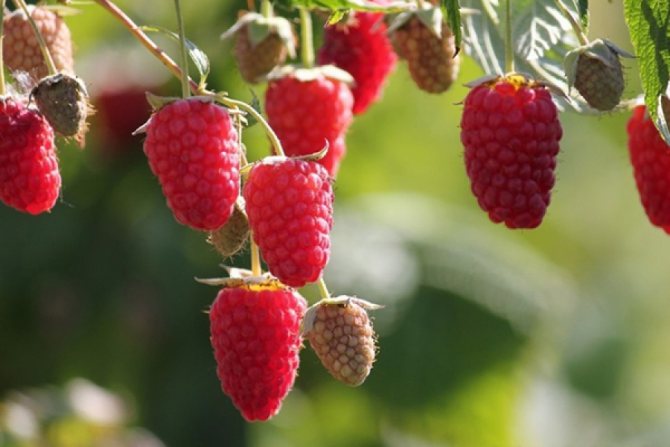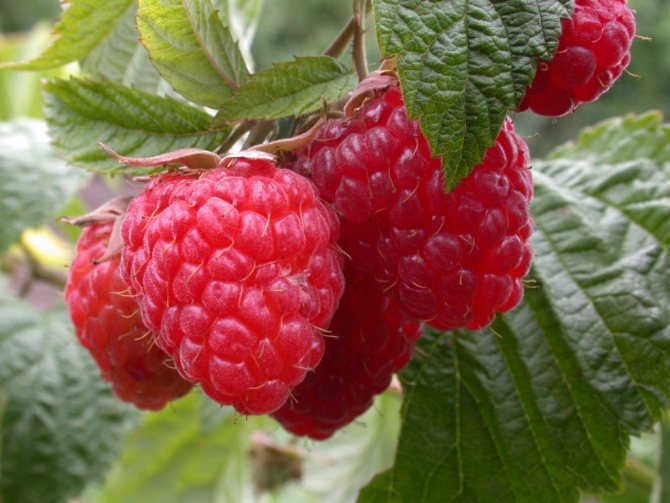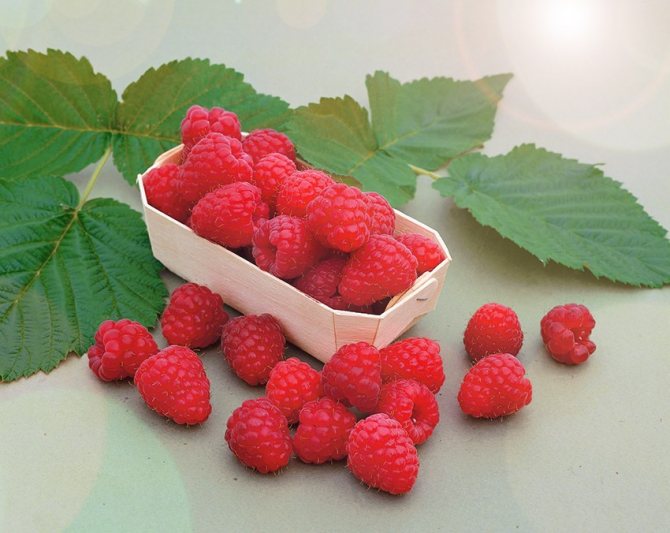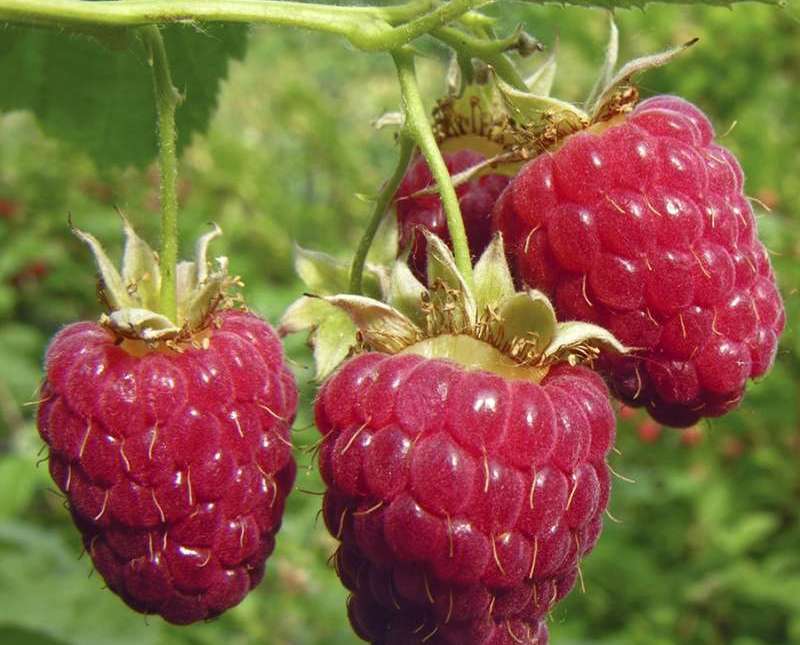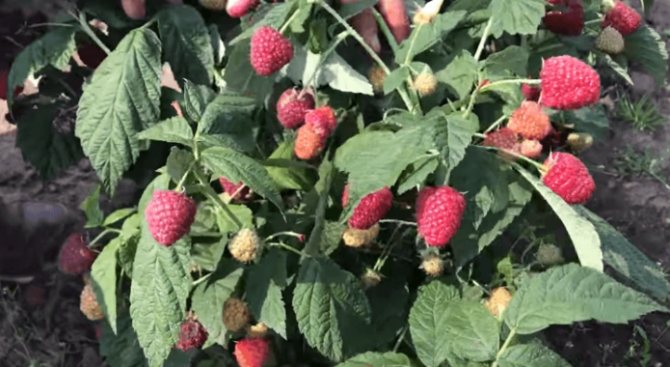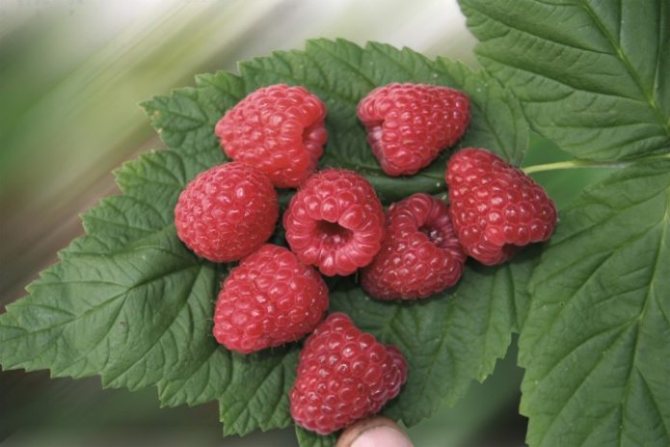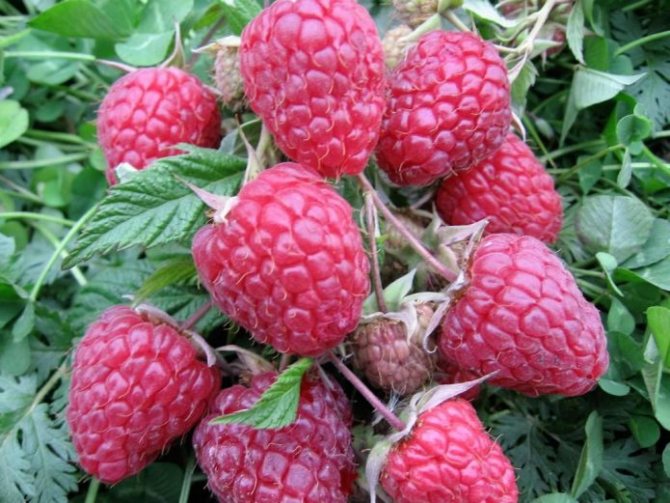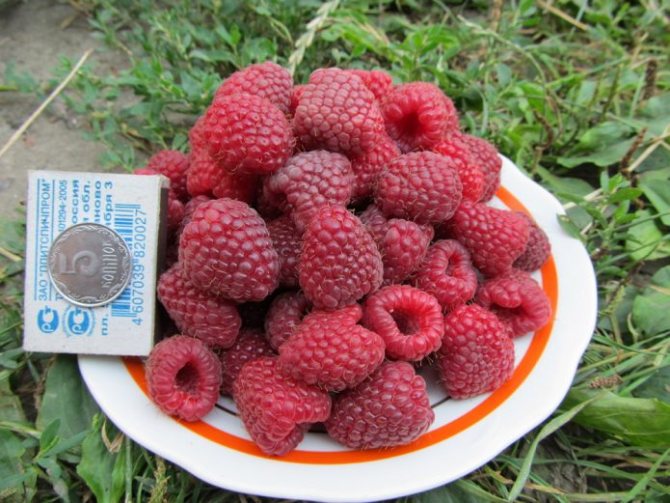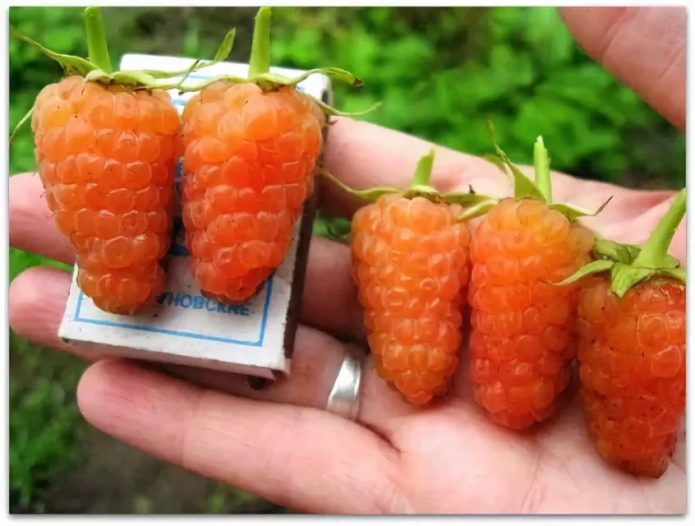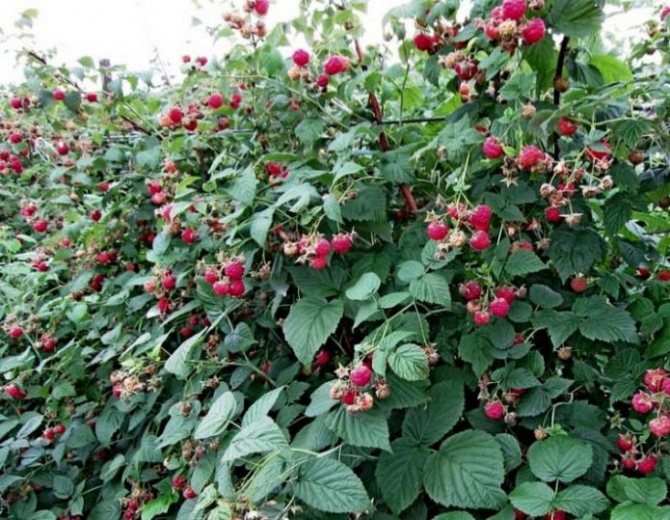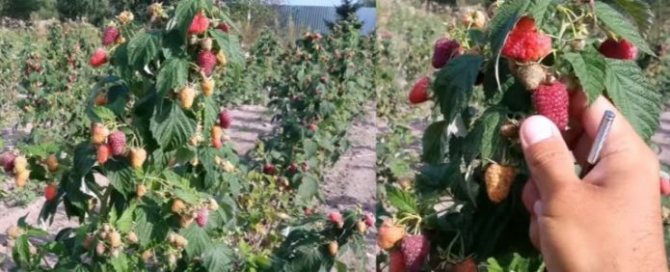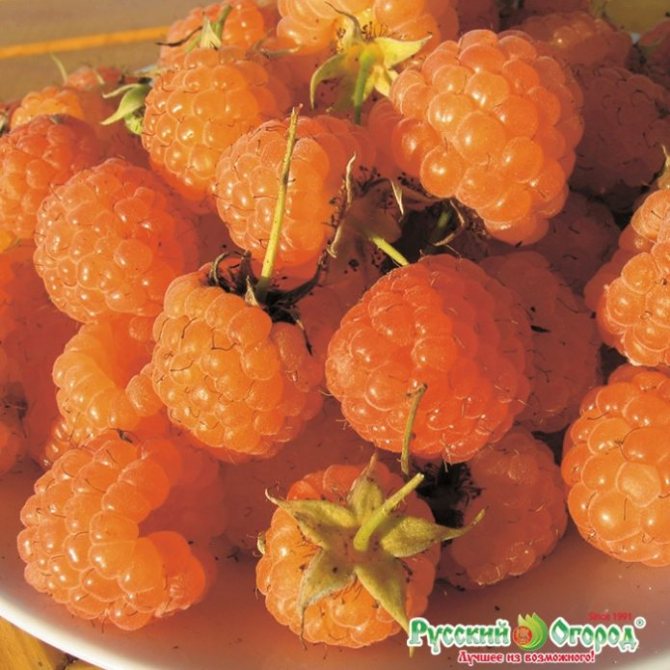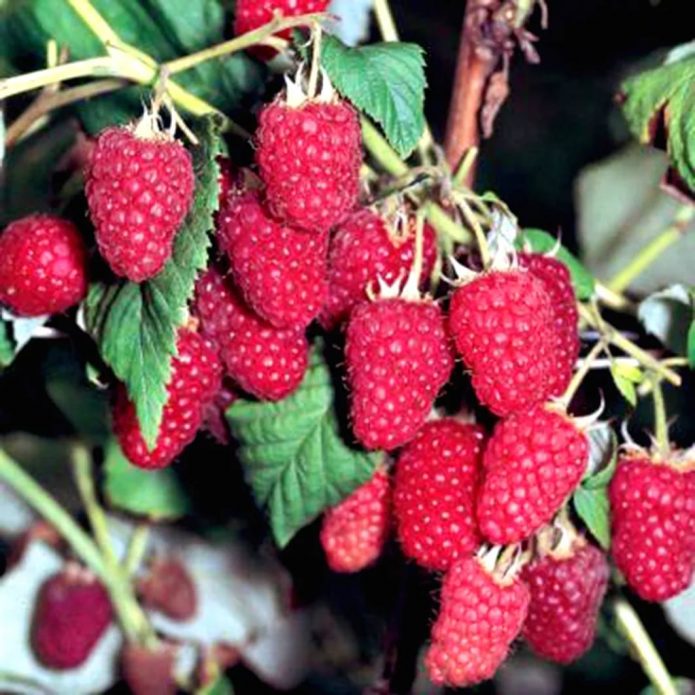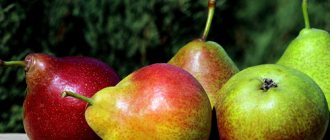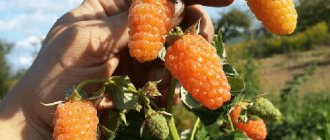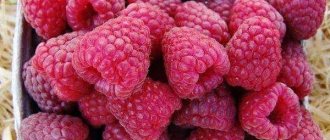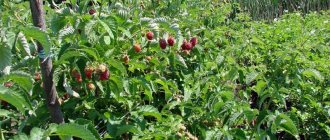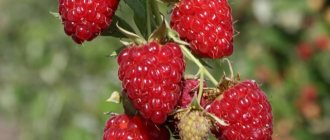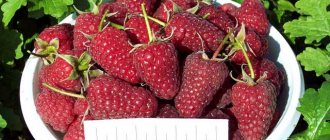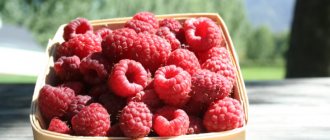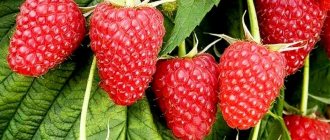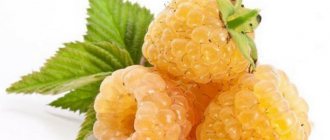Raspberries - that horticultural culture, which, one might say, is best suited for growing in the temperate zone and in the north, and this is true for a larger territory of Russia.
Of course, many varieties of this berry grow easily in different climates. But if there is a desire to grow a really high-quality crop, then you should carefully consider the choice of a suitable variety for your site.
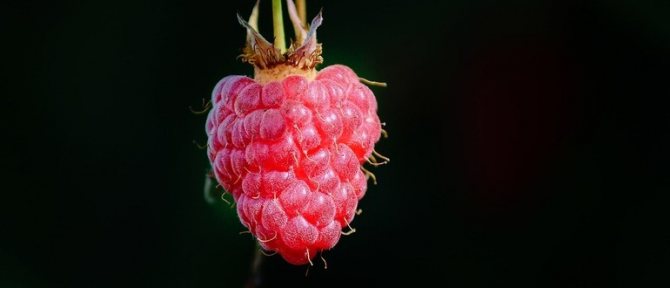
By ripening period
All garden crops are characterized by the classical division into early, mid-season and late varieties. There is also a slightly more accurate classification that includes mid-early and mid-late species. Raspberries have a sufficient number of varieties for each of the listed characteristics.
Early
The most important feature of early raspberry varieties is fast ripening. Most species bear fruit as early as June. If climatic conditions permit, then picking berries will turn out until the end of summer at least.
The early varieties are perfect for the northern regions of the planet, where the first cold weather comes already at the end of September, which is why it is important to collect ripe fruits as soon as possible.
Bryansk miracle
On the bushes of the Bryansk Divo variety, classic red raspberries, but somewhat elongated, ripen. High yield (up to 3-4 kg per bush) and rather large berries (up to 10 grams each) are the main competitive advantages.
Often, this particular variety is used in growing for sale, as it is well stored, practically does not lose its appearance during transportation, and has a classic taste.
But the raspberry "Bryansk Marvel" is demanding on the fertility of the soil, and loves a lot of sun.
Secrets of craftsmanship. "Bryansk miracle" begins to bear fruit from top to bottom: from top to bottom. For larger and more juicy berries, the lower row of flowers can be torn off to direct the plant's forces to the upper ovaries.
Hercules
As the name suggests, Hercules berries are large in size. But this is not the only feature. So, "Hercules" ripens one of the very first of all homemade raspberries (already in early to mid-June), has a powerful immunity, well resisting most diseases and pests traditional for raspberries.
However, raspberries "Hercules" are considered poorly resistant to cold weather (for the winter it is highly recommended to additionally cover the bushes), slowly growing (it is more difficult to propagate).
Read more about leaving in our article.
Zyugan
One of the most unpretentious varieties from the cohort of early varieties. "Zyugana" perfectly tolerates even intense heat, but demonstrates the best yield in the shade and partial shade.
The berries grow in a classic red color and are medium in size (5-7 gr.).
But they are dense and solid, which makes them easy to transport and can be stored for a long time.
Medium early
Raspberries of medium early varieties can be attributed to a universal cultivation option in most of Russia and other northern countries. At the same time, the plants do well in the south, invariably bearing fruit.
Fruiting of mid-early species is long, and can often last from mid-June to early autumn. For this reason, they may be confused with remontant raspberries (the one that produces two harvests per year), but they are actually different species.
Tatyana
A plant with relatively high yields (usually no more than 10 kg per bush), but it bears fruit with consistently large berries.
With good care (watering, feeding, hilling, pruning), the fruits reach up to 20-25 grams. weight each. The berry taste is classic, sweet, with sourness.
"Tatiana" is chosen quite often, because she is literally adapted for unhindered harvesting: the bushes do not grow much, and there are no thorns on the branches.
Reward
"Reward" is considered one of the most unpretentious among all the famous raspberries.
Even if it is not able to give any outstanding harvest (it is noted that no more than 3-4 kg per bush is harvested), and the berries are quite small (up to 4-5 grams), but it feels great outside the black soil, on less fertile soils north.
The taste, shape and color of the berries are classic.
This raspberry is perfect both for fresh consumption and for various dishes, preparations.
Mishutka
Raspberries, which were specially bred in Gorno-Altaysk in order to be grown in the Urals, Siberia and the Far East.
The key characteristic is high frost resistance.
Among other things, the berries are well transported and well stored. Drupes are strong and do not crumble into grains.
The berries ripen in a classic red color, mostly of medium size (up to 7 grams). The yield of the bush does not exceed 4-5 kg.
Mid-season
Mid-season raspberries are the most preferred single-crop variety for temperate regions. Fruiting of such raspberries is considered the most optimal in terms of taste, its peak occurs in August-September. Mid-season species are the best at resisting many plant diseases and common insect pests.
Atlant
One of the most popular varieties, appreciated for the entire harvest of almost perfect shape.
Berries are formed one to one in size, color, quality.
The fruits begin to ripen in August, and the crop is easily grown throughout Russia, Ukraine, Belarus.
But if "Atlant" is badly watered and grown on poor soils in composition, then there can be no question of an ideal harvest.
We emphasize again: "Atlant" is demanding on the abundance of moisture and regular feeding.
Penguin
Low-rise decorative raspberry, which is grown mainly in private households.
The total yield is not the highest - no more than 3 kg per bush.
The berries are usually perfectly round in shape, weighing no more than 5 grams. each one.
The main feature is a neat appearance.
The bushes during fruiting are really heavily covered with neat raspberries.
By the way, the taste of "Penguin" raspberries directly depends on the quality of the soil. The richer the composition, the sweeter the berries grow.
Polana
A product of Polish breeders, which has successfully taken root in households in Ukraine, Russia and Belarus.
Polana is very close to the classic raspberry. She ripens dense, but juicy drupes up to 7 grams. each one.
The bushes grow up to one and a half meters, covered with thorns, but grow slightly.
Care is simple: you just need to water the raspberries on time and feed them at least every spring.
Mid late
Mid-late raspberries take longer to ripen than all other varieties (except, obviously, late ones). But the strong point of most species is resistance to temperature extremes and weather changes. These qualities are relevant in regions that are poorly suitable for agriculture.
Mirage
The variety, bred back in 1978, has quite successfully taken root since then in many garden farms in Russia and some countries of the former USSR.
This raspberry tolerates heat and frost and can produce good yields.
The maximum performance is 5 kg per bush and rather large berries of 5-8 grams.
This raspberry is appreciated for its excellent ease of care.Fruiting in the second year after planting.
Peresvet
It was bred specifically for central Russia (the latitude of the Bryansk, Smolensk and other regions).
"Peresvet" is close to common raspberries. The berries are sweet, with a subtle sourness, red or dark red hue.
Fruiting begins in mid-July and lasts up to 6 weeks.
The yield of the bush is estimated at 4-6 kg. The average berry weight rarely exceeds 5-6 grams.
Glen Coe
Scottish raspberry, different from many other purple berries with a whitish bloom, good resistance to cold and wind, rather large conical berries (up to 7 grams).
The main feature is the complete absence of thorns on the branches.
Late
The quality of ripening fruits always speaks in favor of late raspberries. Firstly, by the time of harvest, at the end of summer, they receive a maximum of useful substances. Secondly, they usually have the most intense taste and long-lasting smell. Thirdly, the plant itself is more resistant to diseases and pests than earlier varieties.
However, late crops are almost impossible to grow in regions where frost occurs in October-November.
Polka
The variety demonstrates high versatility.
In addition to the fact that it gives consistently good yields, it is a little sick and takes root on almost any soil.
Berries keep well.
"Polka" has few thorns, and the bushes do not overgrow much - all this makes it easier and faster to harvest.
Taganka
Extremely frost-resistant variety. It is chosen mainly by residents of the regions north of Moscow.
Despite the difficulties with collection (the bushes are overgrown and abundantly covered with small thorns), even in not the most favorable conditions, the berries still appear.
It will be possible to collect up to 6 kg of berries from the Taganka variety as much as possible.
Tarusa
A very winter-hardy and prolific raspberry variety for the northern regions.
The bushes can withstand up to 30 degrees of frost, and if they are covered, then more.
The peculiarity of this northern variety is that it bears a record high.
Up to 1 kg of berries can be harvested from each shoot, and up to 10-12 such branches grow in the bush.
And the fruits themselves are quite impressive, often growing up to 7-9 grams. everyone.
Hercules
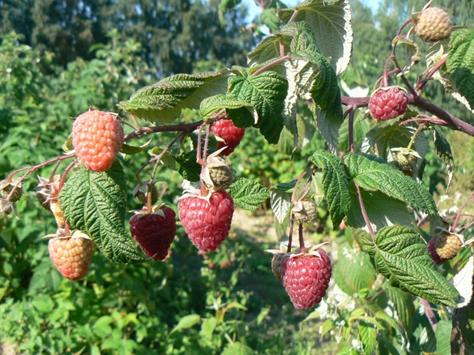

Bush medium-sized, slightly spreading. Shoot-forming ability is low. The shoots are strongly thorny.
Features of the: begins to bear fruit in the 1st year after planting. The yield potential before the onset of autumn frosts is realized by 90-95%.
Berries very large (average weight - 3.8-5.0 g), truncated conical shape, ruby color. The pulp is sweet and sour.
Using: Suitable as a dessert and for technical processing.
Dignity: The variety is winter-hardy, productive (10 t / ha).
Disadvantage: The variety is moderately affected by gray fruit rot.
By fruit size
Another important characteristic for choosing a variety of raspberries is the size of its fruits - drupes. In wild and traditional varieties, small berries with an abundance of seeds are more often observed, but they are more beneficial for health. Numerous hybrids are often specially bred to obtain larger fruits and the most pleasant taste.
Small
Small raspberries are those that rarely exceed 5-6 grams. in weight.
Bryansk jubilee
This is a very small-fruited variety, the berries on which do not grow more than 5-6 grams.
The total yield is also not amazing - up to 2.5-3 kg per bush.
But care for such raspberries is practically not required.
If the soil is moderately fertile, then raspberries will bear fruit without additional help from humans.
Kuzmin's news
Another small-fruited variety that is nevertheless popular in Russia.
Basically, due to excellent unpretentiousness and amazing ability to adapt to the conditions of the area where the bush grows.
Berries grow up to 5-6 grams. weight, and usually not more than 3-4 kg of harvest is harvested from a bush.
Novokitaevskaya
This variety is chosen because it is able to easily survive winter frosts down to -25Co, while it has berries that are acceptable in taste and size (about 7 grams each).
However, the variety itself can be called demanding in terms of care, weak in terms of immunity and difficult to harvest (many thorns and overgrows strongly).
Average
Medium-fruit raspberry varieties differ in berries, the size of which varies from 7 to 14 grams.
Kalashnik
One of the most time-tested varieties, possessing many of the qualities of traditional raspberries, but with larger fruits (normally up to 10-12 grams) and good resistance to some diseases.
Firebird
A popular variety due to the quality of the berries, which grow up to 10 grams. weight.
The variety is very much appreciated in Central Russia, as it does not like hot summers.
And under the condition of a mild and long autumn, it can even give a second harvest.
Meteor
Berries of the Meteor raspberry variety are considered medium in size, although they always weigh quite a bit - about 6-7 grams. each one.
Such raspberries ripen in the first half of summer and are considered the most resistant to fungal infections.
Large
Large varieties of raspberries bear fruit with berries up to 20 grams. each one. However, it can be difficult to grow a really large crop - it is important that the raspberry bush does not experience any discomfort and is grown as correctly as possible.
Patricia
A successful variety for Central Russia, Belarus, which bears fruit with berries from 14 gr. each one.
Fruiting begins early, already in the first half of summer.
The berries are traditional in taste, shape and smell; they are well suited to be eaten fresh or as part of any known berry dishes.
Eurasia
The variety has several advantages at once: firstly, versatility in terms of growing on a variety of soils and climatic zones (hence the name), and secondly, early ripening of fruits (up to 15 grams each berry).
"Eurasia" has excellent immunity, which is rare in such large-fruited varieties.
Golden domes
Berries on this variety grow from 10 grams. each one.
But the main feature is the yellow color of the fruit.
Otherwise, the variety is completely traditional in taste and smell.
Bushes of the variety grow up to 2 meters. The total yield is estimated at up to 5 kg per bush.
Sales routes and sales markets
Raspberry is a tender berry. It will not be stored for a long time. Maximum a week at a temperature of 3-5 ° C. Therefore, you need to sell it quickly, "right from the bush." Where:
- In the markets. The retail price is more attractive than the wholesale one. And if you sell in jars of half a liter - a liter, it will turn out even more profitable. But it’s better to think of the market as one of the many sales outlets: you don’t sell much here.
- At grocery stores. Agree in advance and sell at a wholesale price.
- In restaurants and children's cafes. Various raspberry desserts are often prepared here. They will buy little. Therefore, you can sell at a certain average price between wholesale and retail.
- In pharmacological companies and pharmacies. Raspberries are useful not only fresh, but also dried.
The berry business is profitable. The undoubted leader among the demanded berries is raspberry. It is actively bought both fresh and frozen or as candied fruit, jam, etc. This product has the best taste and useful properties.
By colors
Today raspberries exist not only in traditional red, burgundy colors, but with yellow, orange and even white fruits. Although the most popular and widespread variant of raspberries is still considered to be the classic red-fruited varieties.
Yellow
Quite an unusual yellow raspberry, although in all characteristics it rarely differs in anything from traditional varieties.
Golden autumn
Most often, the variety is chosen for its pleasant sweetish taste, the excellent ability of the berries to be stored and transported.
The yield sometimes reaches up to 9 kg per bush.
Runaway
A fairly low-yielding variety - only up to 2-3 kg of harvest from a bush - but it is valued for something else. First of all, for its incredible unpretentiousness - in fact, the bush grows by itself.
Secondly, "Beglyanka" is often grown as an ornamental crop, as it exudes a strong, pleasant aroma.
Yellow giant
Raspberries, sometimes growing up to 3 meters in height (although in this case they run wild), with fruits up to 6-8 grams. everyone.
This variety has excellent frost-resistant qualities, as it was bred by breeders from the Far East.
More details in our article.
Traditional reds
The classic raspberry has a red fruit color. The most varieties of red raspberries have been bred in the world, so choosing an option for your site is usually not difficult.
Scarlet Sails
The variety has low shrubs and small fruits (up to 5 grams of weight), but excellent survival rate and high immunity.
Only the appearance of pests will have to be closely monitored and dealt with in time.
Yields on "Scarlet Sails" are stable and abundant.
Lazarevskaya
Easy to grow, which is why the variety is often found in most households.
The berries grow medium in size, and the entire yield per bush is kept at about 3 kg annually.
The fruits are perfect for jam, but when fresh they are poorly stored and lose their appearance during transportation, as they are very soft.
Modest
Mid-season raspberry that attracts gardeners because it requires almost no maintenance.
At the same time, the plant exhibits surprisingly strong immunity and suffers only from the invasion of a spider mite (this is easily corrected by annual treatments).
The fruits grow medium in size and weigh up to 4-6 grams. everyone. Another plus is a stable yield from year to year, despite the weather.
Orange
Orange varieties are easy to confuse with yellow varieties. They are indeed very similar in color, taste and shape. However, some varieties have their own flavor. Often in the form of a particularly sweet taste.
Orange miracle
Medium to large fruit variety with a pronounced sweet taste.
The yield of the variety is also pleasing - it rarely drops below 7-8 kg from each bush.
The details of leaving are in our article.
Orange giant
A large-fruited variety with good immunity, but most importantly - a rare, very bright color of berries.
It is also valued for its versatility - it can be planted both in the Middle Lane and to the north and south without losing the quality of the crop.
You can often come across this opinion.that "Orange Giant" is considered the sweetest of all raspberries.
White
A very rare raspberry, especially in private gardening. However, these varieties are also gaining popularity. First of all, the high content of vitamin C is appreciated in white raspberries, as well as the minimum likelihood of an allergic reaction to its fruits.
Spirina white
A variety named after the breeder V.V. Spirin who received it.
In fact, it does not have a white tint, but rather a light yellow.
The bushes grow poorly and produce a minimum of root processes.
Because of this, the variety is easy to care for. "White Spirina" is not a very productive variety, but the berries are considered standard in terms of sugar content and aroma.
Altai dessert
The variety with berries is closer to yellow (as it ripens).
However, at first, the fruits are painted in a pale green color and remain so for a long time.
This raspberry is very cold resistant and has a classic berry flavor. But her immunity is weak.
Amber
In fact, it is a variety of bright yellow fruit.
However, in a large number of sources, it is classified as a variety of white raspberries.
Amber bushes are extremely decorative, berries grow in neat, attractive bunches.
True, there may be problems with harvesting - first of all, due to the rapid shedding of the berries immediately after ripening.
Zeva Herbsternte
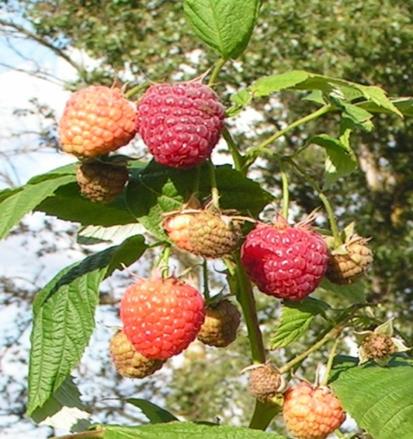

Bush medium-sized compact.Shoot-forming ability is below average. The shoots are strongly thorny.
Features of the: begins to bear fruit in the 1st year after planting. The yield potential before the onset of autumn frosts is realized by 70-80%.
Berries large (average weight - 4.0 g), conical, ruby color. Good taste pulp. Tasting score - 4.2 points.
Using: A variety of universal use.
Dignity: The variety is winter-hardy, productive (3 t / ha).
Disadvantage: The variety is affected by gray fruit rot.
You can get acquainted with the varieties of common raspberries here:
You can order seedlings of raspberry and other fruit and berry crops here:
You can order a service for planting raspberries and other seedlings here:
Material prepared by: gardening specialist Buinovsky O.I.
Are you thinking of planting a raspberry tree? Are you afraid that the seedlings will not take root? To surely get a high yield of large berries, you should buy remontant raspberries from a trusted seller.
The farm "Sad" offers more than 15 varieties of remontant raspberry seedlings. We sell promising varieties that have been selected for 25 years of work.
Repaired
The key feature of remontant raspberries is the ability to produce several harvests per year. As a rule, this quality is relevant only for the middle zone or the south, where it is warm, early summer and long autumn.
Repaired raspberries can be grown in the north, but they turn into regular varieties, giving no more than one harvest per season.
Features of caring for remontant varieties are in our article.
Reliable
For gardening, raspberries are almost ideal.
Firstly, ripe raspberries do not fall off the bushes for up to 2 weeks.
Secondly, the berries have a sweet, bright taste.
The variety bears fruit from the middle of summer, and under favorable conditions gives berries until the first frost, right up to November.
Monomakh's hat
A very productive variety that gives up to 6 kg of fruit per bush. Some fruits even reach 20 grams. weight. "Cap of Monomakh" - a variety with an autumn harvest more abundant than a summer one. Therefore, it is much preferable to breed such raspberries in temperate climates.
Daughter of Hercules
A variety bred from the famous "Hercules".
Its main qualities are abundant fruiting already from mid-summer, the ability to harvest until late autumn, incredibly large berries (from 10 to 20 grams).
Apricot
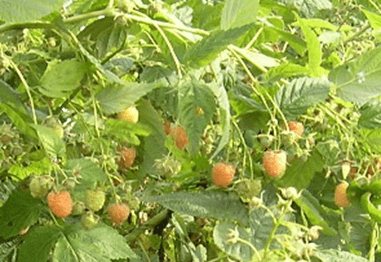

Bush undersized, slightly spreading. Shoot-forming ability is low. Slightly spiny shoots.
Features of the: begins to bear fruit in the 1st year after planting. The yield potential before the onset of autumn frosts is realized by 90-100%.
Berries medium (average weight - 2.5 g), blunt-conical, golden-apricot color. Dessert taste pulp
Using: Suitable as a dessert.
Dignity: The variety is winter-hardy, fruitful (7 t / ha), slightly affected by gray fruit rot.
Stamp
Standard raspberry varieties are bred specifically to facilitate harvesting. Unlike classic varieties, standard varieties start up one or only a few low shoots, which are easy to care for and set the desired growth vector.
Standard varieties are almost always high-yielding, but whimsical to care for.
Galaxy
The most famous standard variety that bears fruit with strong and large berries.
Perhaps the only disadvantage of the variety will be the poor tolerance of the transportation of fruits and the short shelf life of the harvested crop.
Sturdy
Standard variety, with medium ripening of berries (usually in the middle of summer).
Fruiting can be until the end of autumn.
For Russia, one can appreciate such qualities as the frost resistance of "Krepysh" and a fairly strong immunity.
Story
Suitable for connoisseurs of mid-season varieties.
The main feature of the Skazka raspberry is the highest yield - you can harvest up to 12 kg from each bush.
Moreover, the harvested crop lies well and does not deteriorate during transportation.
Raspberry varieties for the south of Russia
Early and hot spring is a characteristic feature of this region. Therefore, it is better to plant bushes in the fall, spring plantings do not have time to take root to high summer temperatures and die, despite constant watering.
- Glen Fine. Medium ripening with extended fruiting period, drought tolerant. The berries have a pleasant taste and a long shelf life. The plant is not whimsical in cultivation, it always gives a high yield.
- Glen Emple. Received the highest rating for heat resistance. The fruits are very sweet and fragrant, the average weight is 4-5 grams, but there are giants up to 10.
- Joan G. A repaired variety with an average ripening period. There are no thorns. The berry is sweet without sourness, fleshy, dark red in color.
- "Pride of Russia". Early maturing, large-fruited type with high productivity.
Southern Raspberry - Glen Emple
The middle zone of Russia is characterized by hot summers and severe winters. All kinds of aromatic berries grow in this region. But nevertheless, the following seem to be optimal:
- "Bryansk Marvel". This fragrant, sweet berry is specially bred for the middle band.
- Atlant. Possesses increased winter hardiness and duration of fruiting.
- "News of Kuzmina". Large sweet berries. The yield is average. Winter hardiness is high.
- "Early surprise". A very early variety with beautiful ruby, sweet fruits.
Raspberry "Early Surprise" is early maturing
- Glen Fine. Medium ripening with extended fruiting period, drought tolerant. The berries have a pleasant taste and a long shelf life. The plant is not whimsical in cultivation, it always gives a high yield.
- Glen Emple. Received the highest rating for heat resistance. The fruits are very sweet and fragrant, the average weight is 4-5 grams, but there are giants up to 10.
- Joan G. A repaired variety with an average ripening period. There are no thorns. The berry is sweet without sourness, fleshy, dark red in color.
- "Pride of Russia". Early maturing, large-fruited type with high productivity.
Southern raspberry variety - "Glen Emple"
Frost-resistant varieties
As a rule, the main qualities of winter-hardy varieties of raspberries are early ripening, strong immunity and resistance to cold weather. High-quality winter-hardy varieties must withstand frosts down to -30Co, even if they are not additionally covered with foliage, branches and snow for the cold season.
Vera
Variety "Vera" is semi-spreading and low (up to 1.5 m in height), belongs to the medium-yielding varieties.
But they choose him for his excellent ability to endure even very severe Siberian or Ural frosts.
Vera's berries are tasty, but they are poorly placed and just as poorly transported.
Hussar
The variety is a godsend for cold climates, since it gives medium and large berries, while remaining resistant to cold temperatures below -25Со.
Otherwise, these raspberries are very close to traditional varieties.
Growing details are in our article.
Shiny
A very unpretentious variety that can withstand many of the vagaries of the weather in the northern regions and the Siberian region. Raspberries are not afraid of drought and long cold weather (but it is better to cover this variety with foliage and snow before wintering).
Raspberries "Shiny" are medium in size, rarely exceed 5 grams. in weight.
Elegant
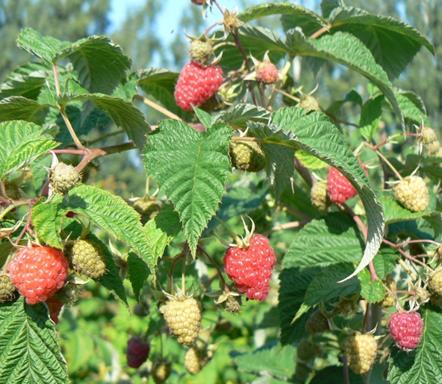

Bush medium-sized, slightly spreading. Shoot-forming ability is average. Shoots are medium spine.
Features of the: begins to bear fruit in the 1st year after planting. The yield potential before the onset of autumn frosts is realized by 80-90%.
Berries large (average weight - 3.5-4.0 g), conical, red in color. The pulp is sweet and sour.
Using: Suitable as a dessert and for technical processing.
Dignity: The variety is winter-hardy, productive (15 t / ha), slightly affected by gray fruit rot.
Varieties suitable for different regions
Raspberries are a popular culture in Russia, not only in private gardening. RF is the world leader in the collection of this berry.
In this regard, numerous bred varieties were created, including with a focus on different climatic conditions in different regions of the vast territory of the USSR, and then Russia.
For Siberia
In Siberia, raspberry varieties pay the most attention to their ability to withstand severe frosts in winter.
Siberian fire
Mid-season variety with medium-sized berries.
Fruiting in August-September.
Gift of Siberia
Dessert variety of raspberries, bearing fruit towards the end of summer.
The berries grow large on it.
Barnaul
Quite fast growing variety with excellent survival rate and reproduction
But the berries on it are small and more suitable for processing into jam or other preservation.
For the Urals
Gardeners in the Urals also select varieties that can withstand frosts in winter, but pay attention to the strength of immunity, since in the hot summer in the Southern Urals, raspberries can be attacked by pests or diseases.
Indian summer
A very unpretentious variety that can easily survive both heat and severe frosts.
It grows compactly and quite steadily yields a yield of 4-5 kg from each bush.
Unattainable
The cultivar begins to bear fruit towards the end of summer and the fruiting period is short.
However, most of the berries ripen almost at the same time, which is convenient for harvesting.
Chief
Very hardy variety.
Which, moreover, bears fruit quite abundantly, with large, aromatic, sweet berries.
The average yield of a bush is up to 5 kg.
For Krasnodar Territory
Raspberries are one of the few crops that don't like extreme heat. However, if you grow it in the shade and partial shade, then the Krasnodar summer will allow you to get more than one harvest of high-quality berries. In the south, you can give preference to remontant varieties, picking raspberries all summer and most of autumn without any problems.
Heritage
Sufficiently small-fruited raspberries.
However, the collection rate from the bush rarely drops below 4 kg.
This is enough to collect really a lot of raspberries in conditions of southern heat.
Apricot
A yellow-fruited culture, the main feature of which is the presence of a large amount of resins and esters in the composition.
Especially smelling jams, salads, canning are obtained from it.
Crane
An unpretentious raspberry that is not afraid even of direct sunlight.
It is only important to water this variety.
The fruits of the "Zhuravlik" are small, but they are well stored and stay on the branches for a long time after ripening.
For the middle lane
Usually, gardeners try to take into account the resistance of the variety to frost in Central Russia (cold snaps occur up to -30Co), but also good heat tolerance in the long summer.
Pride of Russia
The most popular variety, with large (up to 12 grams) berries, abundant fruiting (up to 5-6 kg per bush) and strong immunity.
Although care requires - first of all, tying up branches, and secondly - feeding the bushes every year.
More information in the article on our website.
Ruby giant
An undemanding variety, the main feature of which is considered to be a yield of up to 9-10 kg. from the bush.
Large berries have a sweet taste, store well and are easy to transport.
Elegant
It grows in rather neat, non-spreading bushes.
Harvesting with these raspberries is easy.
The warmer and longer the summer, the larger and better the yield of the variety.
For the Leningrad region
The conditions for gardening in the Leningrad region and in the north-west of Russia are generally similar to those that are typical for the middle zone of the country. But it is advisable to select varieties so that they have enough time to ripen in a relatively short summer.
Cumberland
An American raspberry variety, which, first of all, is not afraid of frosts down to -30Co.
The berries are black and weigh only up to 2-3 grams. each one.
But the overall yield is strikingly high: sometimes more than 10 kg are harvested from the bush.
Brusvyan
A close to the classic variety, which takes root well in forests and semi-steppes.
Fruits in hard, sturdy berries that keep well.
Giant
It is a frost-resistant variety, but its main feature is its especially large berry size.
Even in the conditions of the northern regions, you can grow raspberries up to 25 grams. each one.
Polyana (POLANA)
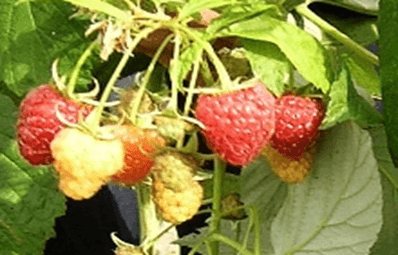

Bush undersized, compact. Shoot-forming ability is low. Shoots are thornless.
Features of the: begins to bear fruit in the 1st year after planting. The yield potential before the onset of autumn frosts is realized by 70-80%.
Berries large (average weight - 3.5-4.0 g), broad-conical, dark red in color. Dessert taste pulp
Using: Suitable as a dessert and for technical processing.
Dignity: The variety is winter-hardy, productive (5 t / ha).
Disadvantage: The variety is affected by gray fruit rot.
Features of agricultural technology
For growing raspberries, sunny areas, protected from strong winds and stagnant water, are best suited. The soil should be loose, breathable and rich in nutrients. The raspberry tree should be free of weeds, especially wheatgrass.
- In addition, you should not plant raspberry bushes next to or after:
- tomatoes;
- potatoes;
- garden strawberries.
- It is useful if previously on the site chosen for the raspberry tree the following grew:
- peas;
- beans;
- beans;
- rape;
- mustard.
Important! In the area where the raspberry bushes were previously located, the raspberry bushes should not be re-planted earlier than 5 years later.
For planting seedlings in spring, summer or autumn, you should:
- Dig a trench with a maximum depth of 0.3 m and a width of 1.5 m.
- Lay peat soil, rotted leaves, sawdust, compost in layers. The layers are interspersed with layers of garden soil with the addition of a small amount of wood ash.
- Immediately before planting, shorten the seedling to 0.5 m in height.
- Loosen the roots from the ground by shaking and place in the trench.
- Cover the root system with soil, while deepening the stem 3 cm into the ground.
- Water the seedling abundantly.
- Mulch wet soil with crushed peat, sawdust or dry humus.
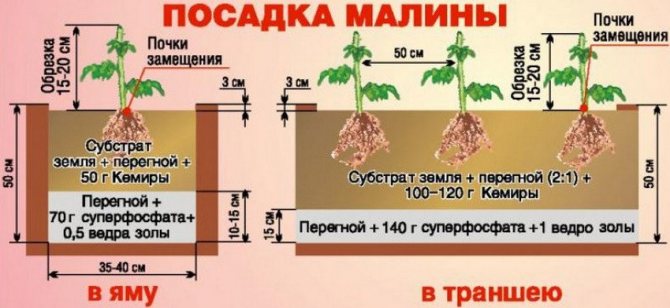

In order to properly grow raspberries, they need follow-up care, which consists of:
- regular watering;
- fertilizing with fertilizers;
- pruning;
- loosening the soil.
Raspberries require frequent watering, especially during the spring or dry summer days. It is advisable to water it with settled water so that the soil is moistened, but at the same time there is no stagnation of moisture in it.
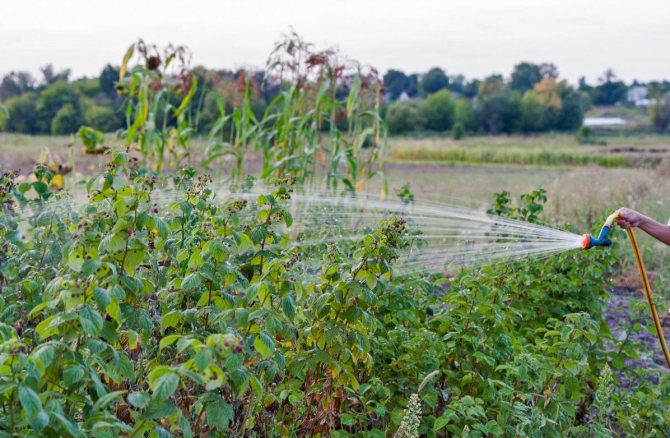

Raspberries respond very well to weeding, which is usually coupled with loosening the soil. In addition, loosening should be done after every watering or rain. This prevents the formation of an earthen crust, which impedes air exchange in the root system of plants.
Brusvyan
A variety bred by Ukrainian breeders in the nursery of the same name. Very powerful shoots (2–2.5 m) and 1.5 cm in diameter at the base. The beginning of raspberry ripening in the one-year cultivation cycle is the first half of August, the end usually falls on October. The berry is large, 10–12 g, and 2.2–2.5 kg can be harvested from the bush. On the shoots of the second year, the berry ripens in June, but not so large. Dense and juicy red pulp with a real raspberry flavor, tasting score from 3.9 to 4.3 points. Good keeping quality and transportability.
Brusvyana, summer fruiting, video
The variety has high heat resistance, but also a high demand for watering.
Large-fruited raspberries: characteristics, features, advantages and disadvantages
This raspberry group includes varieties whose berries are capable of reaching a mass of 4 to 12 g. At the same time, there are record holders with a mass of berries under 20 g. Experienced gardeners, even before harvesting, are able to determine the large-fruited seedlings by elongated flower sepals. The size of the berries in this raspberry group is complemented by a large number of them on each bush, which makes it possible to harvest up to 4–6 kg of harvest from each bush.
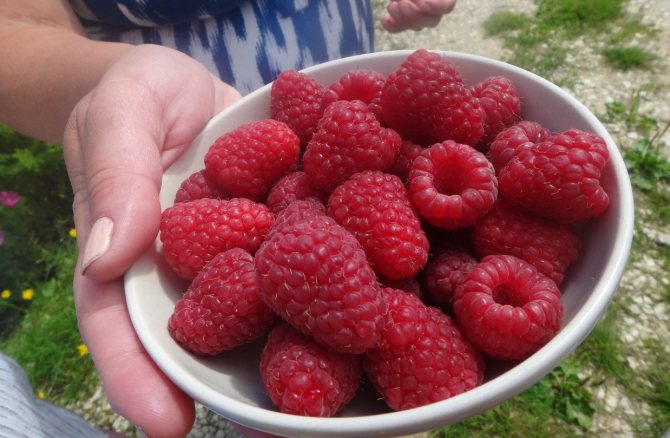

- In addition to high yields, large-fruited raspberries have, in comparison with conventional varieties, the following advantages:
- long fruiting period, reaching 20 years;
- active branching of fruit branches, each of which can grow up to 40 berries;
- high gastronomic quality of berries.
- The disadvantages of this raspberry group include:
- insufficient winter hardiness;
- a small number of replacement shoots, which is why you have to plant more seedlings than when planting ordinary varieties;
- low resistance to diseases and pests.
Did you know? The raspberry fruit is actually not a whole berry at all, but is a polystyrene, consisting of a large number of fused scanty fruits, each of which has its own seed.

